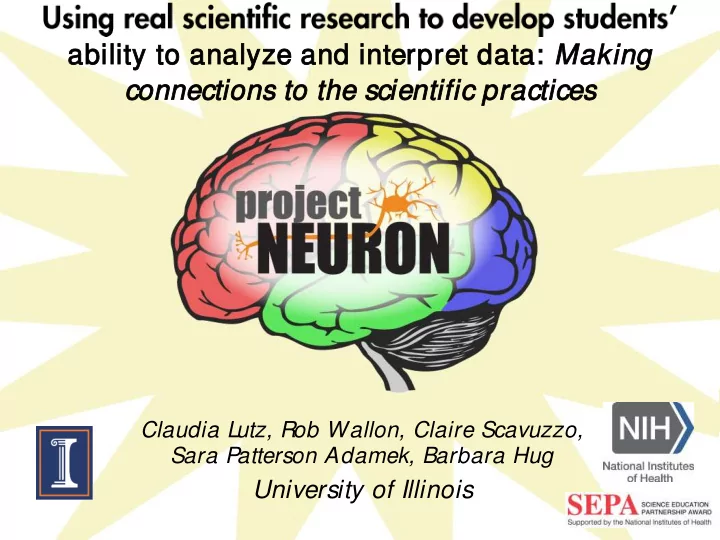

abil ilit ity to a analyze a and in interpret d data: : Makin ing connectio ions to t the s scie ientif ific ic p practic ices Claudia Lutz, Rob Wallon, Claire Scavuzzo, Sara Patterson Adamek, Barbara Hug University of Illinois
Or: : Nature and Nurture; ; analyzin ing t the e evid idence! Claudia Lutz, Rob Wallon, Claire Scavuzzo, Sara Patterson Adamek, Barbara Hug University of Illinois
Session Overview • What is Project NEURON? • Introduce the curriculum unit • Experience a data analysis activity as students • Discuss and provide feedback
W hat is Project NEURON? • Curriculum development – Inquiry-based – Connect to standards • Professional development – Summer institutes – Conferences • Educators, scientists, and graduate students
Project NEURON Curriculum Units • Do you see what I see? – Light, sight, and natural selection What can I learn from worms? • Regeneration, stem cells, and models – Available at: • What makes me tick…tock? neuron.illinois.edu – Circadian rhythms, genetics, and health • What changes our minds? – Toxicants, exposure, and the environment – Foods, drugs, and the brain Why dread a bump on the head? • – The neuroscience of traumatic brain injury (TBI) • Food for thought: What fuels us? Glucose, the endocrine system, and health – • What makes honey bees work together? – How genes and environment affect behavior • How do small microbes make a big difference? – Microbes, ecology, and the tree of life
Project NEURON Curriculum Units • Do you see what I see? – Light, sight, and natural selection What can I learn from worms? • Regeneration, stem cells, and models – Available at: • What makes me tick…tock? neuron.illinois.edu – Circadian rhythms, genetics, and health • What changes our minds? – Toxicants, exposure, and the environment – Foods, drugs, and the brain Why dread a bump on the head? • – The neuroscience of traumatic brain injury (TBI) • Food for thought: What fuels us? Glucose, the endocrine system, and health – • What makes honey bees work together? – How genes and environment affect behavior • How do small microbes make a big difference? Microbes, ecology, and the tree of life –
The Curriculum Unit What makes honey bees work together? • Lesson 1: What do honey bees do? • Lesson 2: Why do honey bees have different jobs? • Lesson 3: How do honey bees heat the hive? • Lesson 4: What is the genetic basis for the evolution of eusocial behaviors?
Nature and Nurture What factors influence behavior? • Genetics (nature) • Environment (nurture)
Nature and Nurture
Nature and Nurture What factors influence behavior? • LS1.B: “ programmed genetic instructions and small differences in their immediate environments activate or inactivate different genes , which cause the cells to develop differently ” • LS3.B: “ Environmental factors also affect expression of traits , and hence affect the probability of occurrences of traits in a population. Thus the variation and distribution of traits observed depend on both genetic and environmental factors .”
Honey Bee Behavior What do honey bees do?
Honey Bee Behavior What do honey bees do?
Honey Bee Behavior • Nurse bees (days 3-11) • Forager bees (days 14-42+)
Honey Bee Behavior • Nurse bees (days 3-11) • Forager bees (days 14-42+)
Activity: Analyzing gene expression data
Activity: Analyzing gene expression data Scientific Practices from the NRC Framework: • Analyzing and Interpreting Data – “ Recognize when data are in conflict with expectations” – “Use graphs . . . to explore relationships between variables” – “ Evaluate the strength of a conclusion that can be inferred from any data set” • Constructing Explanations – “Use primary or secondary scientific evidence . . . to support or refute an explanatory account of a phenomenon”
Activity: Analyzing gene expression data Reading and data interpretation activity • Everyone: background information • Groups (work until 10:20): – Experiment 1 – Experiment 2A – Experiments 2B and 3 – Experiments 4A and 4B • Discuss in groups, use large pads to share your group’s interpretation and conclusions! • Think about how this activity might fit into your classrooms
Analyzing gene expression data: Discussion • Was Amfor expressed in regions of the brain that might have different activity in nurses and foragers?
Analyzing gene expression data: Discussion • How reliable are these data? What could be done to make them more reliable?
Analyzing gene expression data: Discussion • Can differences in Amfor expression be explained by age? What further test could be done to prove this?
Analyzing gene expression data: Discussion • Does this experiment demonstrate correlation or causation?
Discussion • What challenges do your students face with analyzing and interpreting data? – How could you use these lessons in your classroom? – How might you modify these materials to fit with your curriculum?
Acknowledgements • NIH, SEPA • University of Illinois – Project NEURON – Robinson Lab – Institute for Genomic Biology This project was supported by SEPA and the National Center for Research Resources and the Division of Program Coordination, Planning, and Strategic Initiatives of the National Institutes of Health through Grant Number R25 RR024251-03. The contents of this presentation are solely the responsibility of Project NEURON and do not necessarily represent the official views of the funding agencies.
Thanks! For additional information visit: http://neuron.illinois.edu E-mail: neuron@illinois.edu
Recommend
More recommend